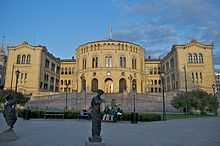Politics and government of Oslo
The Politics and government of Oslo reflects that Oslo is the capital of Norway, and as such is the seat of Norway's national government. Most government offices, including that of the Prime Minister, are gathered at Regjeringskvartalet, a cluster of buildings close to the national Parliament—the Storting.


Governance
Constituting both a municipality and a county of Norway, the city of Oslo is represented in the Storting by seventeen Members of Parliament. Constituting both a municipality and a county of Norway, the city of Oslo is represented in the Storting by nineteen members of parliament. The Labour Party and the Conservative Party have six each, the Progress Party and the Liberals have two each ; the Socialist Left Party, the Christian Democrats and the Green Party have one each
The combined municipality and county of Oslo has had a parliamentary system of government since 1986. The supreme authority of the city is the City Council (Bystyret), which currently has 59 seats. Representatives are popularly elected every four years. The City Council has five standing committees, each having its own areas of responsibility. These are: Health and Social Welfare; Education and Cultural Affairs; Urban Development; Transport and Environmental Affairs; and Finance. The executive branch (Byrådet) consists of the Governing mayor (byrådsleder) and currently seven vice mayors or Commissioners (byråder, sing. byråd) holding ministerial positions. The vice mayors are appointed and removed by the Governing mayor. The Governing mayor and the vice mayors can individually or collectively be voted out of office by the city council. The current Governing mayor is Stian Berger Røsland from the Conservative party.
Since the local elections of 2003, the city government has been a coalition of the Conservative Party and the Progress Party. Based mostly on support from the Christian Democrats and the Liberals, the coalition maintains a majority in the City Council. After the 2007 local elections on 10 September, the conservative coalition remained in majority. The largest parties in the City Council are the Labour Party and the Conservatives, with 18 and 16 representatives respectively.
Mayor
The Mayor of Oslo is the head of the City Council and the highest ranking representative of the city. This used to be the most powerful political position in Oslo, but following the implementation of parliamentarism, the Mayor has had more of a ceremonial role, similar to that of the President of the Storting at the national level. The current Mayor of Oslo is Fabian Stang.
Governing mayor
The Governing Mayor of Oslo is the head of the City government. The post was created with the implementation of parliamentarism in Oslo and is similar to the role of the prime minister at the national level. The current governing mayor is Stian Berger Røsland.
Administrative divisions
Following the latest reform of 1 January 2004, the city is divided into fifteen boroughs (bydeler) that are to a considerable extent self-governed. Each borough is responsible for local services not overseen by the City Council, such as social services, basic healthcare, and kindergartens. Sentrum (the city centre) and Marka (the rural/recreational areas surrounding the city) are separate geographical entities, but do not have an administration of their own. Sentrum is governed by the borough of St. Hanshaugen. The administration of Marka is shared between neighbouring boroughs.